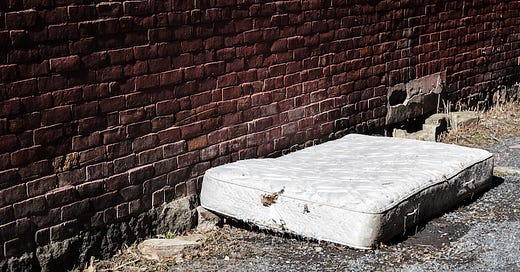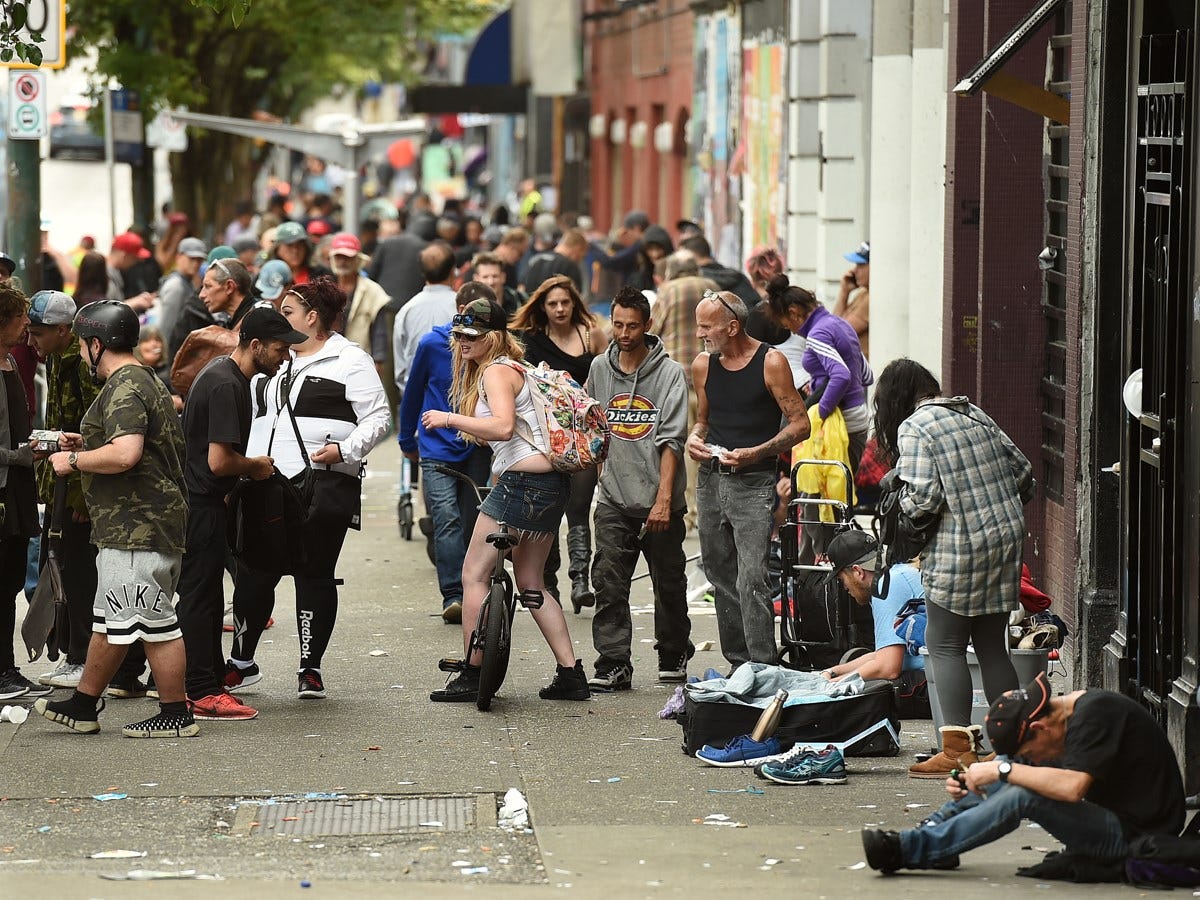When I was around 19 years old, I sub-letted an apartment in downtown Montreal for the summer.
At that time, as far as cities go, Montreal was extremely safe. There were some homeless people and addicts roaming the streets, but there were not many. Montreal’s harsh winters has been a historical bulwark against permanent street living. And back then, in the early 2000s, Canada didn’t have social problems to the degree that it does now.
I remember feeling safe enough to go out at night with friends and then stop for a poutine at 3 am, unmolested.
One night, sometime after midnight, I was on my way home from such an outing. I saw a young homeless man, visibly an addict, lying there on a mattress on the side of the street. Looking frail and skinny, I took pity on him.
I had just bought my first round of groceries for my temporary apartment. Feeling the slight elation of lingering alcohol, but sober enough, I went into my flat and opened the bag of a fresh loaf of bread.
I took out my new jar of peanut bar, and opened up some jam. I proceeded to make him a peanut butter and jam sandwich, put it in a Ziploc bag, and headed back outside to leave it beside him.
I said some kind words to which he was oblivious, and left my humble offering on the mattress next to him.
I felt great.
That night I went to sleep with a smile, thinking I had done a small act of kindness that could bear fruits in the life of that poor soul.
The next morning, the sun was shining brightly. I stepped out and walked towards the subway to head to work, on my way passing by the place where the man had been sleeping.
He was gone.
I stepped closer to the mattress, to his temporary bed, seeing something shining with the reflection of the sun.
It was a plastic baggie, with a peanut butter and jam sandwich inside. Untouched.
My gift had been rejected.
A few years later, a childhood friend was texting me about her brother.
It was seven in the morning, and he was on a bender. He had a serious accident years earlier which almost killed him, giving him abundant access to prescription opiates, which he was now abusing. Like my peanut butter and jam guy, he was an addict.
It wasn’t just a car accident that injured him. I didn’t understand it at the time, but he suffered from all kinds of childhood trauma. He had always been a kind of delinquent, into drugs and other bad habits. He perpetuated the abuse by taking it out on my friend, whom one day had come running over to my house after he threw a knife at her.
But like a wounded puppy, he had the kind of look in his eyes that begged for help and had you feeling sorry for him.
That morning, he was threatening to kill himself. My friend told me that she could no longer help him; she had given up. His mother, apparently, said the same.
I couldn’t just let this happen, I told myself. I got into my car and drove over to his house.
When I got there, he was shocked to see me. He let me in. My mission was to keep him sober and alive for a few hours.
In hindsight, it was incredibly naive and potentially dangerous. But I felt compelled to try and help him.
In the hours that I was there, I attempted an intervention. I spoke to him carefully, and the more sober he got, the more truthful I became. I told him that he had choices; that he was not destined to continue down this path. As the drugs were flushing out of his system, he seemed to understand.
A few months later, at my friend’s birthday party, he was there. Sober.
Shortly after my intervention, it turns out, he checked into rehab. He had been clean for months, was working a stable construction job, and getting his act together.
I felt so proud of myself. Love and compassion can truly help someone to heal, I thought. You can save someone with just the right dose.
A few years later, my friend had to put up a restraining order against him, after he stalked her and uttered death threats her and her child, numerous times.
I thought of the peanut butter and jam sandwich.
Last week, in Vancouver, a man named Adam Lo drove a truck into the crowd at the Lapu Lapu Day Festival, harming dozens and murdering eleven people. Allegedly he had a run in with police shortly before the mass killing spree, and had been reported to authorities by someone close to him for psychiatric evaluation the day of the murders. He was also “under the care of a mental health team and on extended leave in accordance with the Mental Health Act."
“Police had dozens of encounters with Lo related to his mental health.” - Vancouver Sun
Read: everyone knew the guy was unstable and potentially dangerous. The cops don’t know you on a first name basis because you’re a good samaritan. They know you because you’re either engaging in criminal activity, or coming close to the line of doing so. Chances are, if you’re a threat to yourself, like the peanut butter and jam junkie or my friend’s brother, you may be a threat to others too. A public threat.
But lax enforcement of the rule of law, or simply the changes in the law itself, has made Canada (and many other Western nations) a place where your chances of being harmed by the violent actions of others the norm. Politicians and advocates practice and preach “harm reduction”, which neither helps the perpetrators or the potential victims. It harms more than it helps.
We tolerate the intolerable in the name of compassion. Why?
I picture the 19 year old me, brimming with pride for delivering a homemade sandwich in the middle of the night.
Or the 25 year old me, later feeling sorry for the guy who threw a knife at my friend when we were teens.
Wanting to help. Wanting to heal. Wanting to save.
Many of you will be familiar with Thomas Sowell’s description of the unconstrained vs. constrained vision.
summarized it nicely here:Those with “unconstrained vision” think that humans are malleable and can be perfected. They believe that social ills and evils can be overcome through collective action that encourages humans to behave better. To subscribers of this view, poverty, crime, inequality, and war are not inevitable. Rather, they are puzzles that can be solved. We need only to say the right things, enact the right policies, and spend enough money, and we will suffer these social ills no more. This worldview is the foundation of the progressive mindset.
By contrast, those who see the world through a “constrained vision” lens believe that human nature is a universal constant. No amount of social engineering can change the sober reality of human self-interest, or the fact that human empathy and social resources are necessarily scarce. People who see things this way believe that most political and social problems will never be “solved”; they can only be managed. This approach is the bedrock of the conservative worldview.
An unconstrained vision is born out of naivety and toxic empathy. It is the worldview of a young and naive 20-something year old girl, and our nations have chosen it as their moral and legal framework. We are at the point where crazy people and religious fanatics drive trucks into crowds, we publicly mourn, we cross our fingers it doesn’t happen to us, and then move on.
You could say our leaders and populace have an unconstrained vision, and it is making us blind.
But there’s more to it, I believe.
Why do we cling to this vision, not only in our progressive politics, but in our personal lives?
Why are we so invested in saving others?
On the one hand, I think we may have a genuine compassion for the suffering of others, and want to help lift them out of their pain. We may believe in the good in people, and know that beneath the layers of a human’s deeds lies a pure soul, in every being.
On the other hand, we may believe in the good in ourselves.
Our self-image might be tied up in being the empathic one, the compassionate one, the healer, the rescuer; the saviour.
It gives us an enormous ego boost to think that we were the ones who planted a seed of change in someone else.
I remember how I felt when I saw my friend’s brother at the party, sober and “healing”. I remember how I judged her for not intervening, on the day her violent and dangerous brother threatened to kill himself in his drug-induced mania— maybe a cry for help, or maybe a cluster-b manipulation tactic. Maybe both.
I understand now the feeling of superiority it gave me to be the one to try to rescue him, when everyone else had ostensibly abandoned him, and the rush I felt for seemingly succeeding.
On the day she told me she was ordering a restraining order against him, I finally understood. I had not rescued him. He did not want to be saved.
It felt like the morning I woke up and walked by the dirty mattress in Montreal, and found my sandwich untouched and abandoned there.
That day provided me a key insight, which I ignored, and struggle to integrate fully to this day.
It was the insight of a constrained vision.
In this world, you might strive to help people. Sometimes, it’s a valiant thing to do, and you might even succeed.
But learn to know the difference between those who are open to receiving your help, and those who are not. Reserve your compassion for those who will truly benefit from it.
Don’t make a peanut butter and jam sandwich for someone who isn’t going to eat it.






I remember a conversation my husband and I had back when we were still a little bit idealistic, in our mid-20s. We were fantasizing about winning the lottery and talking in concrete terms about how we would use the money to help our friends. But as we talked, we came to an uncomfortable realization that a lot of our friends had problems that no amount of money could solve. It was a major shift in perspective for me to realize that.
What a piece. Both heartwarming and sobering to read. I bet that felt a bit like spilling some of your soul. Much obliged for the wisdom.